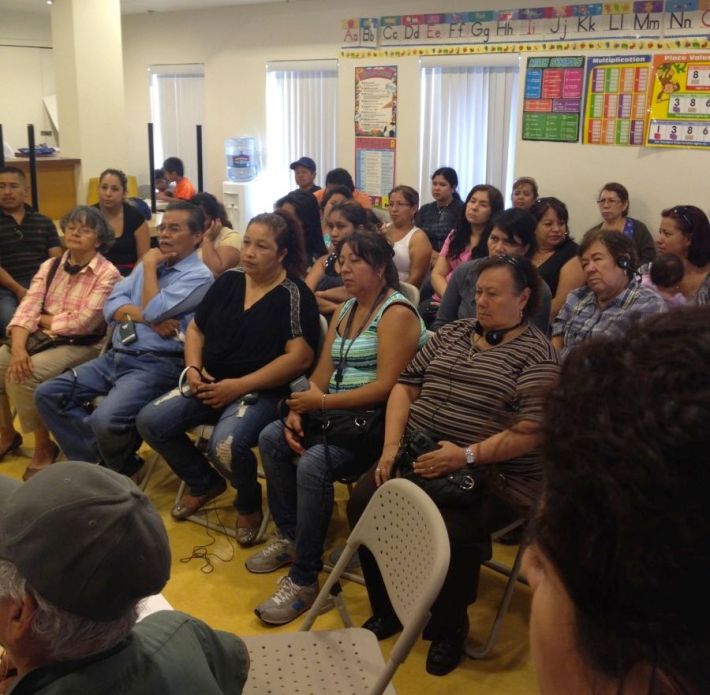
How about a funeral parlor? deadpanned the older gentleman to my right in Spanish. You shouldn't have to go so far to die.
And a florist, the older lady to my left added with a knowing smile. For the funeral parlor...
Touching my arm, she continued, And a sweets shop... before finally collapsing in giggles.
Yes, of course, I said, laughing, because if you're going to die, you might as well have enjoyed yourself.
We were at a design charrette run by the East L.A. Community Corporation (ELACC). They had put the event together to inform Boyle Heights residents in need of affordable housing about their plans to convert an existing 7-unit structure at 1st and Soto to one that would hold about 50 units.
After the facilitators spoke about their affordable housing projects, selection criteria, and other logistical information, they broke the attendees up into 3 groups of 8-10 people. Each facilitator then led the group through an ice-breaker and a discussion of the kinds of amenities people might enhance the new, transit-oriented site. ELACC had already planned for the basics -- now, they wanted to know more about the specific kinds of things people might like to grow in the (proposed) 4000 sq. ft. garden, activities or facilities that would be part of the community space, or businesses that could fill the commercial spaces below the apartments.
The suggestion of a "funeraria" came up as a potential business, I guessed, because of the gentleman's earlier observation that most of the attendees at the event were well above the age of 50.
I wonder if it is only older people that need assistance with housing, he had said to me, looking around the room. You don't see too many young people here.
It was an interesting observation.
Having been a volunteer on and off at Roosevelt High in Boyle Heights over the past few years, I knew that that was not the case. Many of the students I knew spoke openly about having to move from place to place because of economic problems or of having to get jobs to supplement their family's income. One girl (a straight-A student, by the way) I worked with said she often did her homework in the bathtub because, in a two-bedroom apartment where 11 people lived, there were no other quiet spaces available. But I really didn't know why families like theirs weren't present.
Maybe they just don't know about these kinds of opportunities, I had speculated, after telling him about the people I knew. Many don't have access to the internet, so they can't look them up. Or, they either think they won't be able to get the help they need or are too overwhelmed to be able to get to such a meeting?
Hmm, he pondered this. That is a possibility.
Many of the attendees present had been informed about the opportunity through their involvement with ELACC's community organizing program. Others were tenants currently inhabiting the space that would eventually be replaced with the new structure.
Unfortunately, it was probably almost just as well that everyone in the community hadn't known about the event, I thought, after hearing that the waiting lists for some of ELACC's existing buildings can already run anywhere from 6 months to 2 years. For a family with children that is really struggling, waiting in limbo for help can make months feel like years. And the more families that were made aware of the opportunity, the longer the wait list would be.
That sobering reality aside, the workshop was actually lots of fun and a great way for me both to hear about what kinds of things people envisioned for their community and to see how residents' needs or aspirations compared to those of South L.A. (my regular beat for the past 1 1/2 years).
Because it is a predominantly Latino community, most of their suggestions celebrated that heritage, cultural preferences (i.e. crops for the garden), and specific needs (like English classes). But, like people everywhere, I would imagine, they also wanted things that would help them lead more active and healthier lives, such as an exercise room (So we don't get obese! said a woman in her 60s), a computer room and basic instruction, a child care center, a movie night, a pool, and an art space.
When we got into a discussion about the possibility of using the crops produced from the garden as a source of income, people began coming up with all kinds of ideas for interesting income-generating activities.
A cooperative store where the produce could be sold, the older gentleman said, suggesting it could take up one of the commercial spaces in the building.
A handicrafts workshop, suggested another woman, thinking that sewing, jewelry-making, and other classes in the community space could result in products that could be sold.
Organizer Rey Fukuda diligently copied down everything onto several posters, finally turning to the group and asking if everyone was on board with all of the suggestions they had heard.
Yes, everyone nodded.
Minus the funeral home, said a man in his 30s, with a laugh. That's not necessary.






